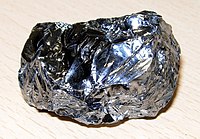
Photo from wikipedia
In the past decades, silicon nanocrystals have received vast attention and have been widely studied owing to not only their advantages including nontoxicity, high availability, and abundance but also their… Click to show full abstract
In the past decades, silicon nanocrystals have received vast attention and have been widely studied owing to not only their advantages including nontoxicity, high availability, and abundance but also their unique luminescent properties distinct from bulk silicon. Among the various synthetic methods of silicon nanocrystals, thermal disproportionation of silicon suboxides (often with H as another major composing element) bears the superiorities of unsophisticated equipment requirements, feasible processing conditions, and precise control of nanocrystals size and structure, which guarantee a bright industrial application prospect. In this paper, we summarize the recent progress of thermal disproportionation chemistry for the synthesis of silicon nanocrystals, with the focus on the effects of temperature, Si/O ratio, and the surface groups on the resulting silicon nanocrystals’ structure and their corresponding photoluminescent properties. Moreover, the paradigmatic application scenarios of the photoluminescent silicon nanocrystals synthesized via this method are showcased or envisioned.
Journal Title: Frontiers in Chemistry
Year Published: 2021
Link to full text (if available)
Share on Social Media: Sign Up to like & get
recommendations!